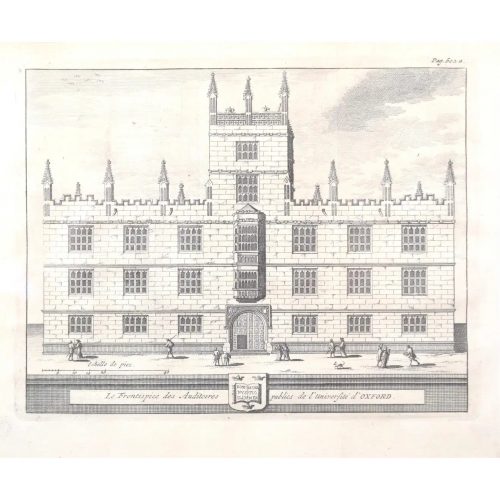-
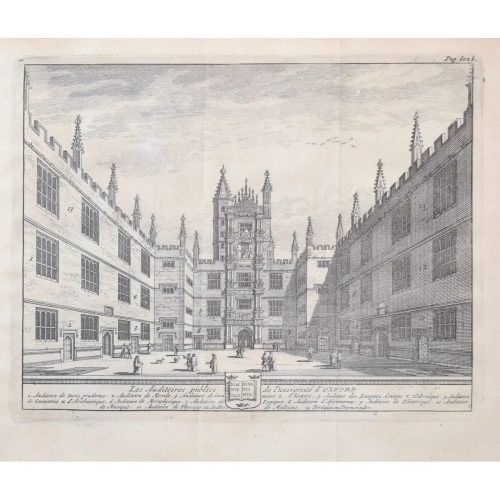
Pieter van der Aa (1659-1733), after David Loggan (1634–1692)
The Public Schools, University of Oxford (1727)
Engraving 12 x 16 cm An eighteenth-century view of the interior of the Public Schools, engraved by Pieter van der Aa after David Loggan, the noted engraver, draughtsman, and painter. Pieter van der Aa of Leiden was a Dutch publisher best known for preparing maps and atlases, though he also printed editions of foreign bestsellers and illustrated volumes. He is noted for the many engravings he produced after David Loggan's series of Oxford and Cambridge colleges and costumes. In 1727 Van Der Aa illustrated "Les Delices de la Grande Bretagne & de L'Irelande" by James Beeverell, the book in which this engraving appears. Condition: a good impression. If you’d like to know more, please email info@manningfineart.co.uk or call us on 07929 749056. -
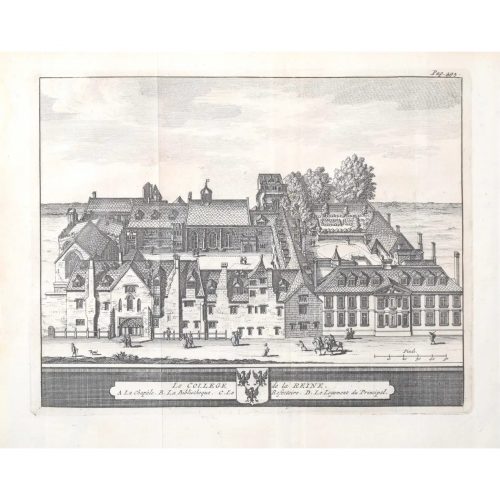
Pieter van der Aa (1659-1733), after David Loggan (1634–1692)
Queen's College, Oxford (1727)
Engraving 12 x 16 cm An eighteenth-century view of Le College de la Reine (Queen's College), engraved by Pieter van der Aa after David Loggan, the noted engraver, draughtsman, and painter. The college was founded in 1341 by Robert de Eglesfield in honour of Philippa of Hainault (the wife of King Edward III). Queen's is known for its predominantly neoclassical architecture, which includes buildings designed by Sir Christopher Wren and Nicholas Hawksmoor. Pieter van der Aa of Leiden was a Dutch publisher best known for preparing maps and atlases, though he also printed editions of foreign bestsellers and illustrated volumes. He is noted for the many engravings he produced after David Loggan's series of Oxford and Cambridge colleges and costumes. In 1727 Van Der Aa illustrated "Les Delices de la Grande Bretagne & de L'Irelande" by James Beeverell, the book in which this engraving appears. Condition: a good impression. If you’d like to know more, please email info@manningfineart.co.uk or call us on 07929 749056. -
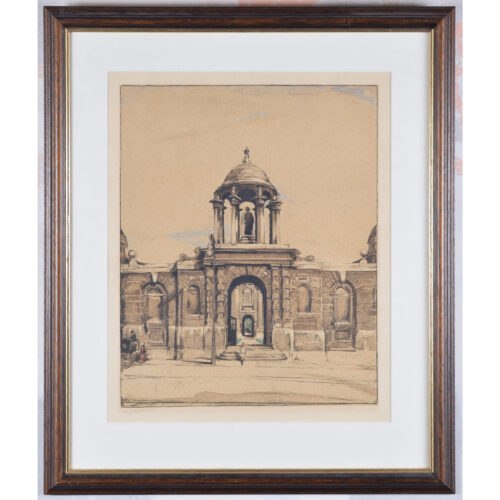
William Nicholson (1872 - 1949)
Queen's College, Oxford
Lithograph 38 x 30 cm Signed lower left. Between 1902 and 1904 William Nicholson lived in Woodstock; during this period he made several architectural studies of Oxford's colleges and other University buildings. Sir William Nicholson was a British painter and printmaker. He is also known as an illustrator, author of children’s books, stained glass designer, and theatre set designer. Condition: very good. If you are interested, please email info@manningfineart.co.uk or call us on 07929 749056. Click here for other views of Queen's College, Oxford. -

Bernard Cecil Gotch (1876-1964)
Queen's College, Oxford
Watercolour 28 x 39 cm (51 x 64 cm framed) Signed lower right. Queen's College in all its leafy glory. The dreaming spires of the University Church of St Mary the Virgin, the Radcliffe Camera, and All Souls peep over the quad. Bernard Cecil Gotch was a Winchester-born artist who is best known for his atmospheric watercolours of Britain's towns and cities (most notably Oxford). He moved to Oxford in 1927, painting many watercolours of the interiors and exteriors of Oxford’s many buildings. His works concentrate on the grand exteriors and interiors of the University's colleges, and he exhibited frequently - including an exhibition every term at Oriel College. His first notable commission was for the publisher Methuen, illustrating 'A Shepherd’s Life' by W H Hudson. Whilst in London he was invited to illustrate a book on the Public Schools of England (which was sadly never completed). He exhibited watercolours at the Fine Art Society and Lincolns Inn, and also exhibited at the Royal Academy. In 1952 Gotch was given an Honorary MA by the University of Oxford, and, after his death in 1963, a memorial was held for him at Oriel. Condition: very good; original frame & mount (some ageing to the latter). If you’d like to know more, please email info@manningfineart.co.uk or call us on 07929 749056. Click here for other views of Queen's College, Oxford. -
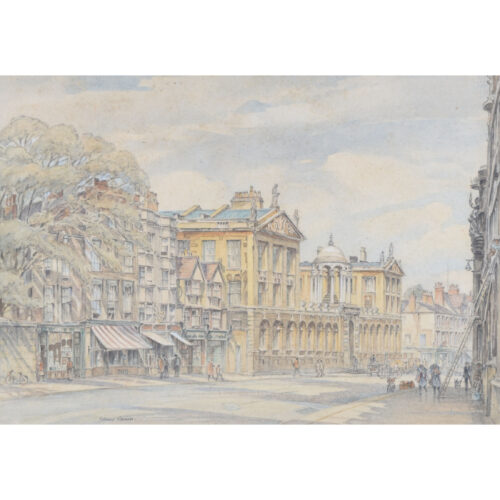
William Sydney Causer (1876 - 1958)
Queen's College, Oxford
Watercolour 38 x 53 cm A most agreeable depiction of Queen's College on the High. The college's Headington Stone is made golden by the sun. William Sidney Causer was a landscape artist known coastal and his urban scenes. He studied at the Wolverhampton School of Art and exhibited at the Royal Academy for the first time in 1923, and later the Paris Salon. Causer painted several pictures in Spain before the Civil War there, and also painted landscapes in France and Italy as well as the English South Coast. Condition: generally very good. If you are interested, please email info@manningfineart.co.uk or call us on 07929 749056. Click here for other views of Queen's College, Oxford. -

R. Phene-Spiers (1838 – 1916)
Tom Tower, Christ Church, Oxford
Signed and inscribed and dated 1880 Watercolour on paper 37x25cm (14.5×9.8 in.) Spiers was educated as an engineer at King’s College, London. Subsequently he was Master of the Architectural School at the RA, and was President of the Architectural Association from 1867-68. -

John Piper (1903 - 1992)
Radcliffe Camera
Lithograph 53 x 35.5 cm Numbered 110/1150 lower left and signed lower right in pencil. John Piper's view of the Radcliffe Camera in Radcliffe Square. John Piper CH was an English painter, printmaker, and designer of stained-glass windows. His work often focused on the British landscape, especially churches and monuments, and included tapestry designs, book jackets, screen-prints, photography, fabrics and ceramics. Condition: very good. Attractively framed; frame included for mainland UK shipping only. If you are interested, please email info@manningfineart.co.uk or call us on 07929 749056. Click here for other views of Oxford. -
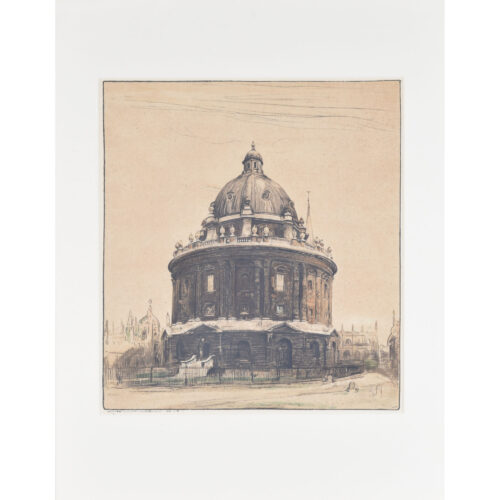
William Nicholson (1872 - 1949)
The Radcliffe Camera, Oxford
Lithograph 35 x 28 cm Signed lower left and numbered 10 in ink. Between 1902 and 1904 William Nicholson lived in Woodstock; during this period he made several architectural studies of Oxford's colleges and other University buildings. Sir William Nicholson was a British painter and printmaker. He is also known as an illustrator, author of children’s books, stained glass designer, and theatre set designer. Condition: very good. If you are interested, please email info@manningfineart.co.uk or call us on 07929 749056. Click here for other general views of Oxford. -

Richard Bankes Harraden (1778–1862)
St John's College, Oxford
Oil on board 24 x 29 cm Richard Bankes Harraden was a printmaker, painter and drawing master. He was active in Cambridge, producing many views of the colleges, and subsequently several Oxford colleges. Harraden was an early and exhibiting member of the Society of British Artists in London, which was established in 1823, and remained a member until 1849. He specialised in depictions of landscape, topography and architecture, and was the son of Richard Harraden (1756-1838) with whom he published plates as 'Harraden & Son'. Condition: A little craquelure and retouching. If you are interested, please email info@manningfineart.co.uk or call us on 07929 749056. -
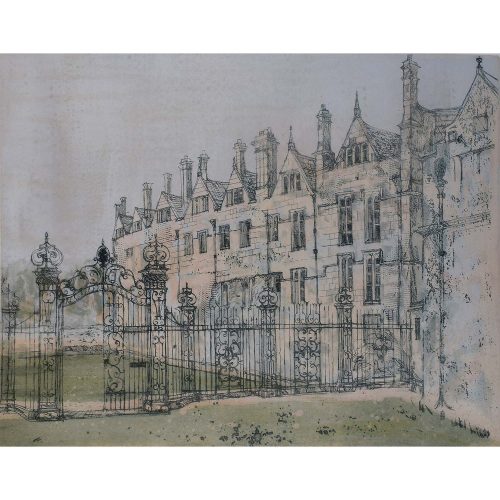
Richard Beer (1928-2017) Merton, Oxford (1964-65)
Colour etching and aquatint 45x60cm 68x85.5 including frame, UK shipping only Signed and numbered 44/100 Click here for biography and other works by this artist. If you are interested email info@manningfineart.co.uk or call us on 07929 749056. Condition: Good. -
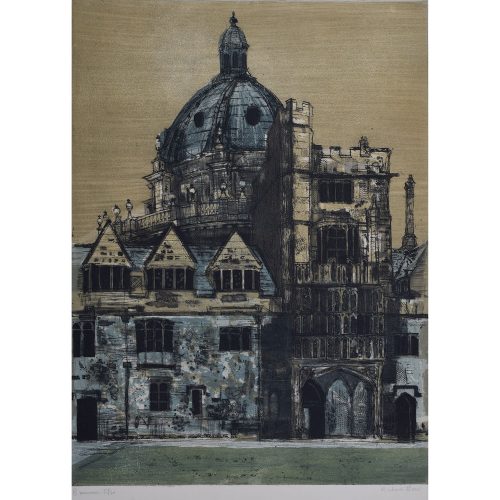
Richard Beer (1928-2017)
Brasenose College, Oxford
Signed print, numbered 55/100 61x44cm A copy of this print is in the Government Art Collection. Click here for biography and other works by this artist. If you are interested email info@manningfineart.co.uk or call us on 07929 749056. -
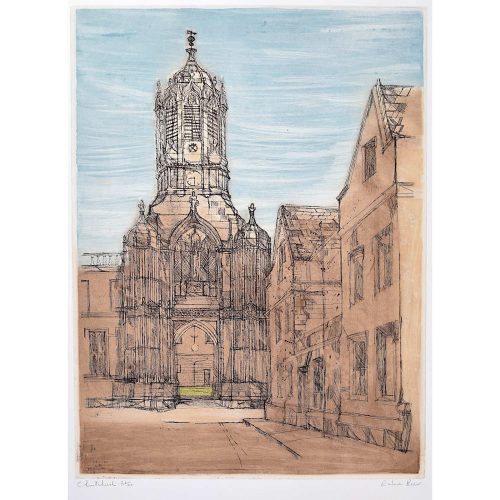
Richard Beer (1928-2017)
Christchurch, Oxford (1964-65)
Signed and titled, and numbered 24/100 Colour etching and aquatint on Velin Arches, published by Editions Alecto 64x48cm Click here for biography and other works by this artist. If you are interested email info@manningfineart.co.uk or call us on 07929 749056. -
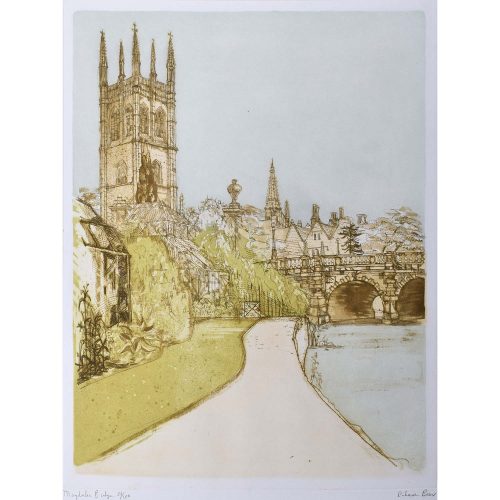
Richard Beer (1928-2017)
Magdalen Bridge, Oxford (1964-65)
Signed, titled and numbered 56/150 Etching and aquatint 57.5 x 44cm Click here for biography and other works by this artist. If you are interested email info@manningfineart.co.uk or call us on 07929 749056. Condition: Good. -
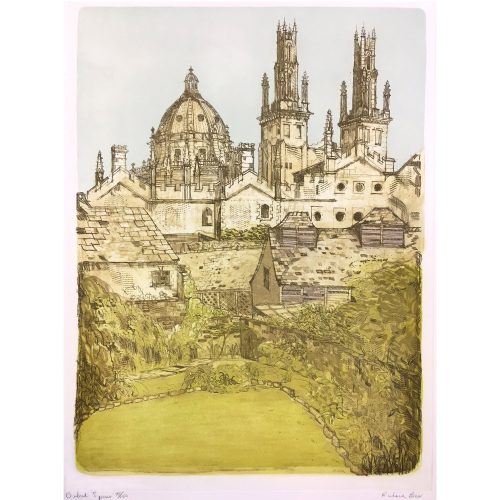
Richard Beer (1928-2017) Oxford Spires - All Souls College and Radcliffe Camera
Limited edition coloured etching signed in pencil and numbered 75/150. 62x44cm Born in London in 1928, just too late to serve in World War II, Richard Beer studied between 1945-1950 at the Slade School. Subsequently, a French Government scholarship allowed him to spend time in Paris at Atelier 17, working under Stanley William Hayter (1901-1988), one of the most significant print makers of the 20th Century – having spent the War in New York, advising as a camofleur, Hayter only returned to Paris in 1950. Subsequently Beer studied at the École des Beaux Arts, Paris. Working for John Cranko, choreographer for the Royal Ballet, Beer designed the sets and costumes for his The Lady and the Fool at Covent Garden, subsequently working for him following his move in 1961 to Stuttgart Ballet. Additionally he produced book illustrations and designed book jackets. Richard Beer taught print-making at the Chelsea School of Art where he was a popular teacher. Probably his greatest work was a collaboration with John Betjeman to produce a portfolio of prints of ten Wren Churches in the City for Editions Alecto, copies of which are in The Government Art Collection. That collection contains a total of 54 prints by Beer, and the Tate Gallery’s collection holds seven. His Oxford series was also produced for Editions Alecto, as was a series of predominantly architectural views in Southern Europe. Most of his prints are of architectural subjects, where he explores the use of colour in interesting fashion. If you are interested email info@manningfineart.co.uk or call us on 07929 749056. Condition: Excellent. -
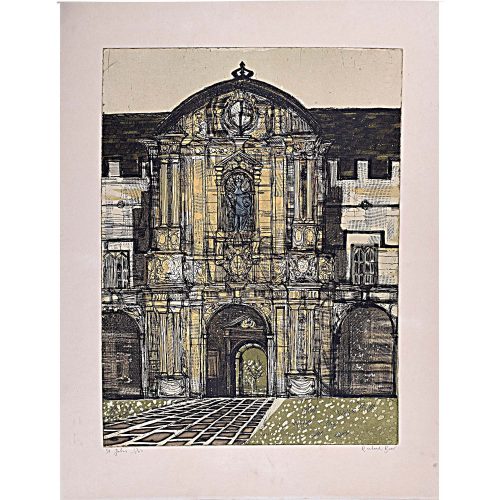
Richard Beer (1928-2017) St John's College, Oxford (1964-65)
Colour etching and aquatint on Velin Arches, published by Editions Alecto 58 x 43 cm Full sheet size 73 x 55.5 cm Signed, titled and numbered 19/100 Click here for biography and other works by this artist. If you are interested email info@manningfineart.co.uk or call us on 07929 749056. Condition: Print in good condition, margins well outside platemark show some discolouration and handling marks which will be hidden behind mat/mount. Mounted to board. -

Richard Beer (1928-2017)
Wadham College, Oxford (1964-65)
Colour etching and Aquatint on Velin Arches by Editions Alecto. 59.8x40cm (23.5×15.7 inches) Proof Print A copy of this print is in the Government Art Collection. Click here for biography and other works by this artist. If you are interested email info@manningfineart.co.uk or call us on 07929 749056. -
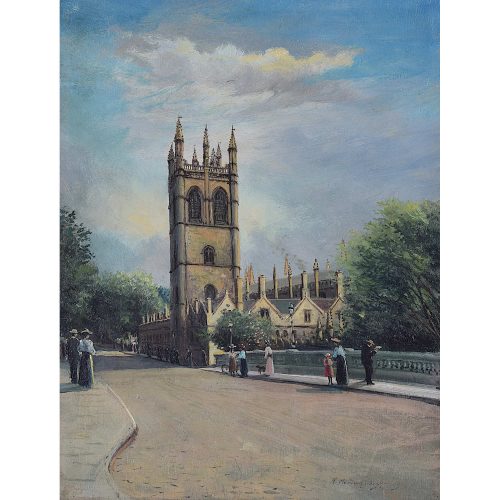
Robert Murdoch Wright (1889-1962)
Magdalen Tower, Magdalen College, Oxford (1910)
Oil on board 35 x 26 cm Signed and dated 1910 Murdoch Wright is best known for his scenes of Egypt, where he travelled and painted widely, see for example this pair sold at Christies. Here he captures Edwardian Oxford with elegantly dressed ladies crossing Magdalen Bridge. Condition: very good; recently cleaned and revarnished. -
 Robert Tavener (1920-2004) Magdalen College, Oxford (artist’s proof) Signed Screenprint 69×48 cm (27.1×18.8 inches) Framed in a gilt frame Click here for biographical details and other works by the artist. If you are interested email info@manningfineart.co.uk or call us on 07929 749056.
Robert Tavener (1920-2004) Magdalen College, Oxford (artist’s proof) Signed Screenprint 69×48 cm (27.1×18.8 inches) Framed in a gilt frame Click here for biographical details and other works by the artist. If you are interested email info@manningfineart.co.uk or call us on 07929 749056. -
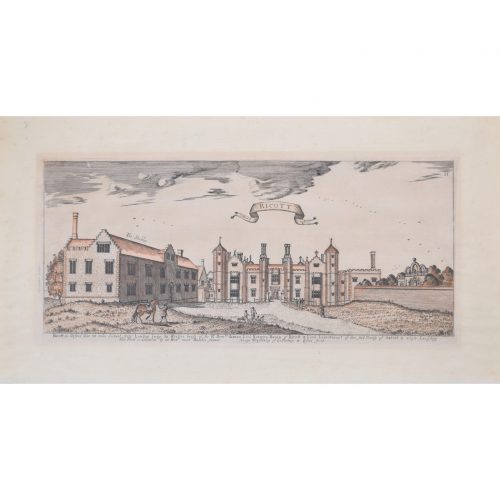
Henry Winstanley (1644 - 1703)
Rycote House, Oxfordshire
Engraving 19 x 44 cm Rycote House, Oxfordshire, was a Tudor (and later Georgian) country house. The house was built in the 16th century, and in 1920, after a period of decline, the extensive stables were converted into the present Rycote House. Condition: generally very good; some age toning. If you are interested, please email info@manningfineart.co.uk or call us on 07929 749056. Click here for other architectural drawings. -
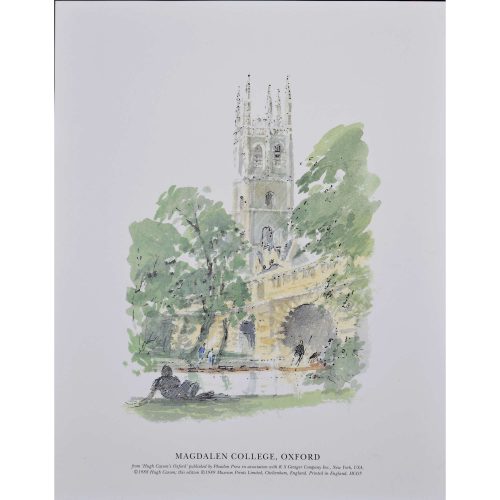
Sir Hugh Casson (1910-1999) Magdalen College Oxford
Unsigned proof print 25x20cm From Casson’s ever-popular Oxford series of prints. Sir Hugh Casson was educated at Eastbourne College, St John’s College Cambridge and the Bartlett School of Architecture. Trained in the 1930s in the early modernist style, he taught at the Cambridge School of Architecture. After employment as a camoufleur during World War 2 by the Air Ministry, in 1948 he was appointed as director of architecture for the Festival of Britain. A close friend of the Royal Family, he undertook designs for the 1953 coronation, designed the interior of the Royal Yacht Britannia (“The overall idea was to give the impression of a country house at sea”), and taught the Prince of Wales to paint in watercolours. Amongst his architectural achievements are the Elephant House at London Zoo, the 1978 redevelopment of Bristol Docks, the Raised Faculty Building for The University of Cambridge, and a building for the Royal College of Art. He published a number of illustrated books, of which Casson’s Oxford and Casson’s Cambridge are probably the best known. A limited edition series of prints was produced from the paintings. If you are interested email info@manningfineart.co.uk or call us on 07929 749056. Condition: Excellent. -
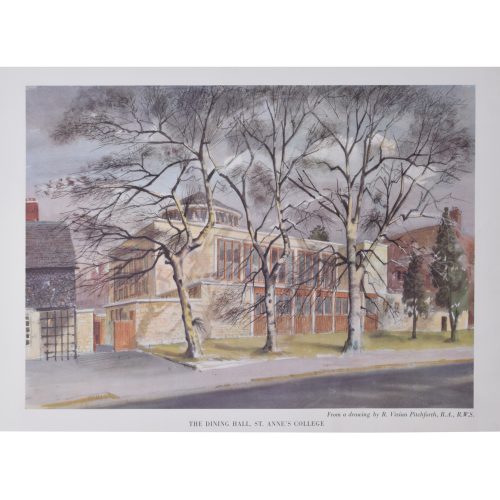
Roland Vivian Pitchforth RA ARWS (1895 - 1982)
The Dining Hall, St Anne's College
Lithograph 33 x 46 cm A lithograph of St Anne's, from a drawing by Roland Vivian Pitchforth. The artist captures the Dining Hall of the college on a blustery day. The modernist dining hall was built in 1959. Pitchforth's drawing was reproduced as a lithograph in 1962, to be published in the "Oxford Almanack". The Oxford Almanack was an annual almanac published by the Oxford University Press for the University of Oxford from 1674 through 2019 (when printing sadly ceased due to "dwindling interest"). The almanac traditionally included engravings or lithographs of the University and information about the upcoming year. Other almanac artists have included James Basire, Michael Burghers, J. M. W. Turner, and John Piper. Roland Vivian Pitchforth was an English painter, teacher and an official British war artist during the Second World War. Condition: very good. If you’d like to know more, please email info@manningfineart.co.uk or call us on 07929 749056. -
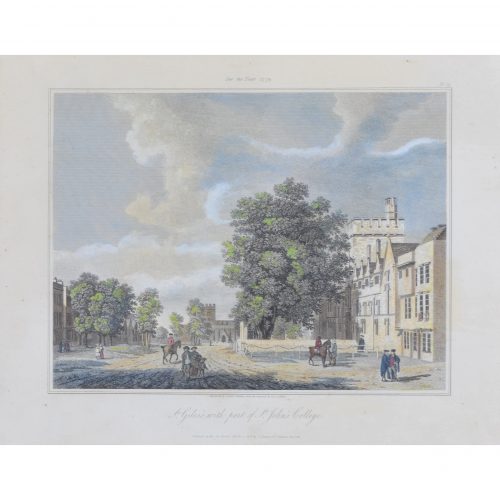
Joseph Constantine Stadler (1755 - 1828) after Michael Angelo Rooker (1743/6 - 1801)
St Giles's with a part of St John's College (1813)
Engraving with later hand-colouring 25 x 32 cm An engraving of St Giles, including the famous St Giles Church, with the front of St John's to the right. Joseph Constantine Stadler was a prolific German émigré engraver of images after his contemporaries. Stadler's engravings are wide-ranging in subject matter and include landscapes, seascapes and portraits, as well as military, sporting and decorative subjects. Stadler was employed by the leading print publisher of the time, John Boydell. Stadler lived in Knightsbridge when he died at the age of 73. Michael Angelo Rooker ARA was an English oil and watercolour painter of architecture and landscapes, illustrator, and engraver. Condition: good. Some gentle age toning. If you are interested, please email info@manningfineart.co.uk or call us on 07929 749056. Click here for other views of St John’s College, Oxford. -
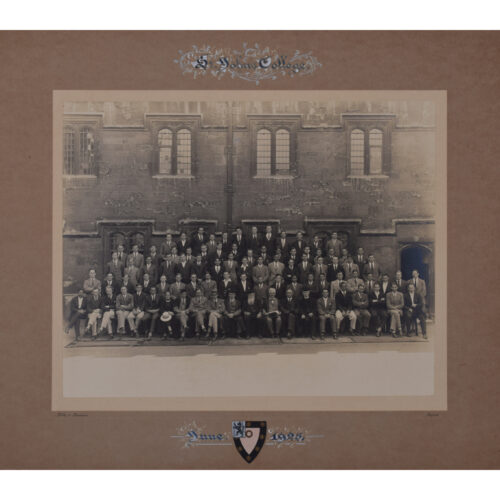
Hills and Saunders
St John's College, Oxford (1925)
Silver gelatin photograph with extensive hand-decoration of mount 43 x 49 cm A photograph taken of St John's College students and tutors in 1925. Hills & Saunders was one of the leading Victorian social photography firms. Robert Hills and Henry Saunders started the firm together in 1860 and had studios in Oxford, Cambridge, and London during the course of their partnership, as well as near certain army bases and public schools. They were given a Royal Warrant in 1867. Condition: generally very good. If you are interested, please email info@manningfineart.co.uk or call us on 07929 749056. Click here for more St John's pictures. -

Bryan de Grineau (1883 - 1957)
The Hall, St John’s College, Oxford
Pencil 34 x 56 cm Signed and titled lower right. Drawing published in The Illustrated London News, 18 June 1955. Condition: very good. Click here for other views of St John’s College by this artist and biographical details. If you are interested, please email info@manningfineart.co.uk or call us on 07929 749056. -
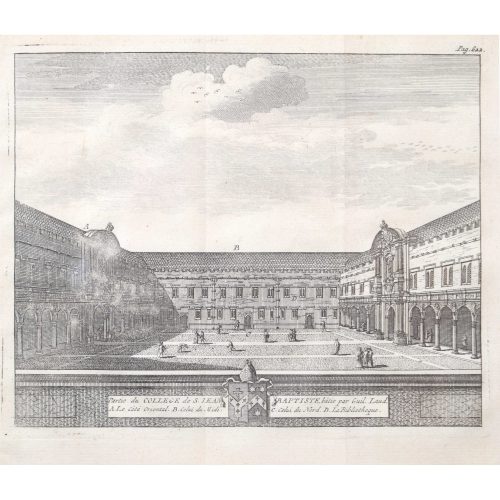
Pieter van der Aa (1659-1733), after David Loggan (1634–1692)
St John's College, Oxford (1727)
Engraving 12 x 16 cm An eighteenth-century view of Canterbury Quad, St John's, engraved by Pieter van der Aa after David Loggan, the noted engraver, draughtsman, and painter. Pieter van der Aa of Leiden was a Dutch publisher best known for preparing maps and atlases, though he also printed editions of foreign bestsellers and illustrated volumes. He is noted for the many engravings he produced after David Loggan's series of Oxford and Cambridge colleges and costumes. In 1727 Van Der Aa illustrated "Les Delices de la Grande Bretagne & de L'Irelande" by James Beeverell, the book in which this engraving appears. Condition: a good impression. If you’d like to know more, please email info@manningfineart.co.uk or call us on 07929 749056. -
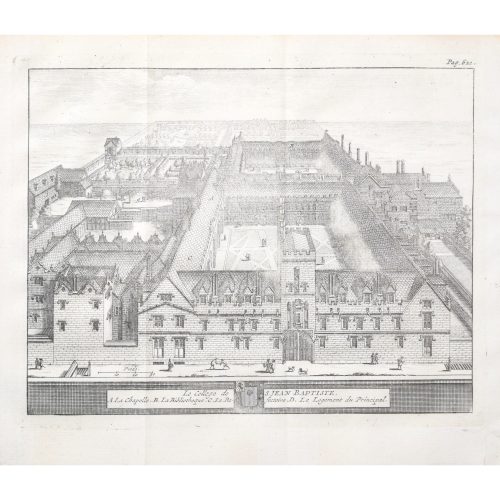
Pieter van der Aa (1659-1733), after David Loggan (1634–1692)
St John's College, Oxford (1727)
Engraving 12 x 16 cm An eighteenth-century view of St John's, engraved by Pieter van der Aa after David Loggan, the noted engraver, draughtsman, and painter. Pieter van der Aa of Leiden was a Dutch publisher best known for preparing maps and atlases, though he also printed editions of foreign bestsellers and illustrated volumes. He is noted for the many engravings he produced after David Loggan's series of Oxford and Cambridge colleges and costumes. In 1727 Van Der Aa illustrated "Les Delices de la Grande Bretagne & de L'Irelande" by James Beeverell, the book in which this engraving appears. Condition: a good impression. If you’d like to know more, please email info@manningfineart.co.uk or call us on 07929 749056. -

Bryan de Grineau (1883 - 1957)
Canterbury Quad, St John’s College, Oxford
Pencil 46 x 34 cm Signed and titled lower right. Drawing published in The Illustrated London News, 1955. Click here for other views of St John’s College by this artist and biographical details. Condition: very good. If you are interested, please email info@manningfineart.co.uk or call us on 07929 749056. Click here for other views of St John's College, Oxford. -
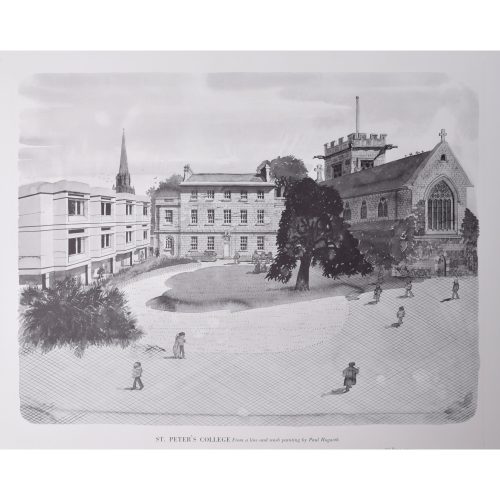
Paul Hogarth
St Peter's College, Oxford (1982)
Lithograph 33 x 46 cm A lithograph of St Peter's, from a line and wash painting by Paul Hogarth. Hogarth's view shows Linton Quad, with the chapel on the right; the chapel was built in 1874 and incorporated some of the stone of an earlier church on the site. Dons and undergraduates pace across the quad, and birds fly over the Latter Building and past the city's dreaming spires. Hogarth's line and wash painting was reproduced as a lithograph in 1982, to be published in the "Oxford Almanack". The Oxford Almanack was an annual almanac published by the Oxford University Press for the University of Oxford from 1674 through 2019 (when printing sadly ceased due to "dwindling interest"). The almanac traditionally included engravings or lithographs of the University and information about the upcoming year. Other almanac artists have included James Basire, Michael Burghers, J. M. W. Turner, and John Piper. Condition: very good. If you’d like to know more, please email info@manningfineart.co.uk or call us on 07929 749056. -
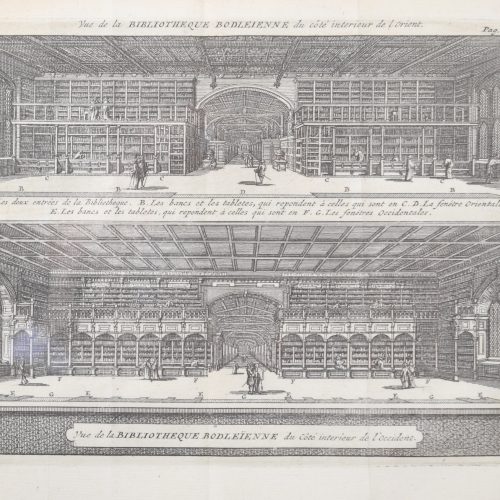
Pieter van der Aa (1659-1733), after David Loggan (1634–1692)
The Bodleian Library, University of Oxford
Engraving (1727) 12 x 16 cm An eighteenth-century view of the interior of the Bodleian Library, engraved by Pieter van der Aa after David Loggan, the noted engraver, draughtsman, and painter. Pieter van der Aa of Leiden was a Dutch publisher best known for preparing maps and atlases, though he also printed editions of foreign bestsellers and illustrated volumes. He is noted for the many engravings he produced after David Loggan's series of Oxford and Cambridge colleges and costumes. In 1727 Van Der Aa illustrated "Les Delices de la Grande Bretagne & de L'Irelande" by James Beeverell, the book in which this engraving appears. Condition: a good impression. If you are interested, please email info@manningfineart.co.uk or call us on 07929 749056. -
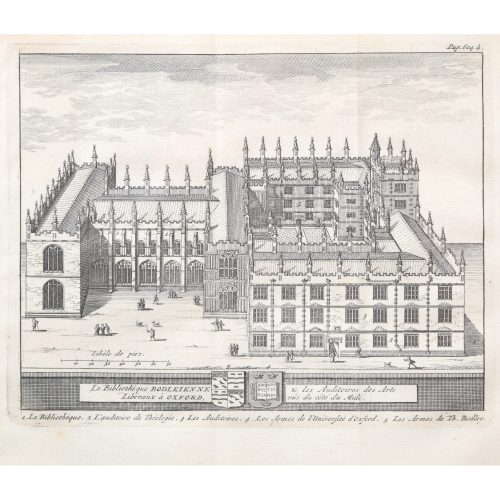
Pieter van der Aa (1659-1733), after David Loggan (1634–1692)
The Bodleian Library, Oxford (1727)
Engraving 12 x 16 cm An eighteenth-century view of the beautiful Bodleian Library, engraved by Pieter van der Aa after David Loggan, the noted engraver, draughtsman, and painter. Pieter van der Aa of Leiden was a Dutch publisher best known for preparing maps and atlases, though he also printed editions of foreign bestsellers and illustrated volumes. He is noted for the many engravings he produced after David Loggan's series of Oxford and Cambridge colleges and costumes. In 1727 Van Der Aa illustrated "Les Delices de la Grande Bretagne & de L'Irelande" by James Beeverell, the book in which this engraving appears. Condition: a good impression. If you’d like to know more, please email info@manningfineart.co.uk or call us on 07929 749056. -
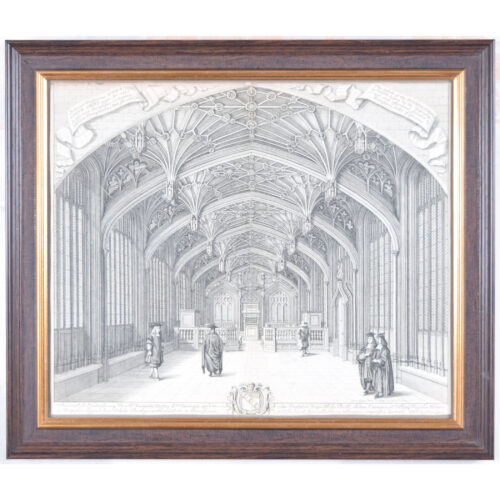
David Loggan (1634 - 1692)
The Divinity School, Oxford (1675)
Engraving 33 x 41 cm David Loggan's view of Oxford's medieval Divinity School, which was once the beating heart of theological studies at the University. Of particular interest here is the trompe l'oeil scroll of torn paper which frames the view. Loggan was born to English and Scottish parents, and was baptised in Danzig in 1634. After studying engraving in Danzig with Willem Hondius (1598-1652 or 1658), he moved to London in the late 1650s, going on to produce the engraved title-page for the folio 1662 Book of Common Prayer. He married in 1663 and moved to Nuffield in Oxfordshire in 1665. Loggan was appointed Public Sculptor to the nearby University of Oxford in the late 1660s, having been commissioned to produce bird’s-eye views of all the Oxford colleges. He lived in Holywell Street as he did this. The 'Oxonia Illustrata' was published in 1675, with the help of Robert White (1645-1704). Following its completion, Loggan began work on his equivalent work for Cambridge; the 'Cantabrigia Illustrata' was finally published in 1690, when he was made engraver to Cambridge University. The 'Oxonia Illustrata' also includes an engraving of Winchester College (Winchester and New College share William of Wykeham as their founder) whilst the 'Cantabrigia Illustrata' includes one of Eton College (which shares its founder, Henry VIII, with King’s College). Bird’s-eye views from this era required a particular talent as an architectural perspectivist; it was not until 1783 that it became possible for artists to ascend via hot air balloons and view the scenes they were depicting from above. Loggan thus had to rely on his imagination in conceiving the views. Loggan’s views constitute the first accurate depictions of the two Universities, in many ways unchanged today. Whilst the Oxford engravings were produced in reasonable numbers and ran to a second edition by Henry Overton (on thicker paper and with a plate number in Roman numerals in the bottom right-hand corner), those of Cambridge were printed in much smaller numbers. The Dutchman Pieter van der Aa published some miniature versions of the engravings for James Beverell’s guidebook to the UK, 'Les Delices de la Grande Bretagne' (circa 1708). The contemporary artist Andrew Ingamells (born 1956) has produced a highly-acclaimed series of etchings which bring Loggan’s original vision up to date. Condition: trimmed within platemark and mounted to board, otherwise in very good condition. If you are interested, please email info@manningfineart.co.uk or call us on 07929 749056. Click here for other general views of Oxford. -
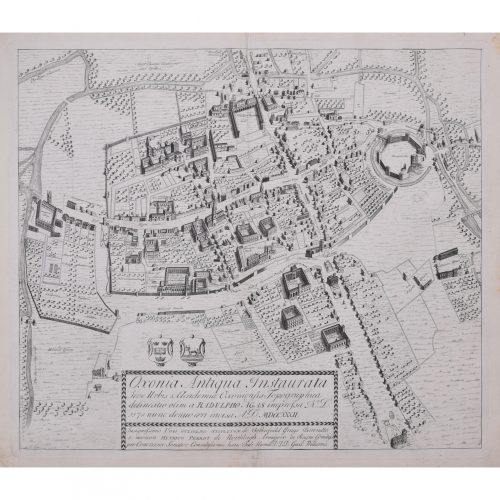
William Williams (Welsh, active 1724 - 1733)
The First Map of Oxford (1733)
Engraving 47 x 54 cm In 1578, Ralph Agas drew the first ever map of Oxford, studded with the first colleges of the University. In 1733 it was engraved by William Williams for publication in the Oxonia Depicta, a book of illustrations depicting similar views as David Loggan's volume of engravings. Ralph Agas was an English surveyor and cartographer. He was born in Suffolk and lived there throughout his life, although he travelled regularly to London. He began to practise as a surveyor in about 1566, and has been described as "one of the leaders of the emerging body of skilled land surveyors". regular work consisted of drawing up local estate maps and surveys for a variety of clients. He was one of the first estate surveyors to move beyond the traditional practice of compiling purely written descriptions of landed property, and to supplementing them with measured maps. Condition: generally very good; a few marks to margins. Central fold as issued. If you’d like to know more, please email info@manningfineart.co.uk or call us on 07929 749056. Click here for other general views of Oxford. -
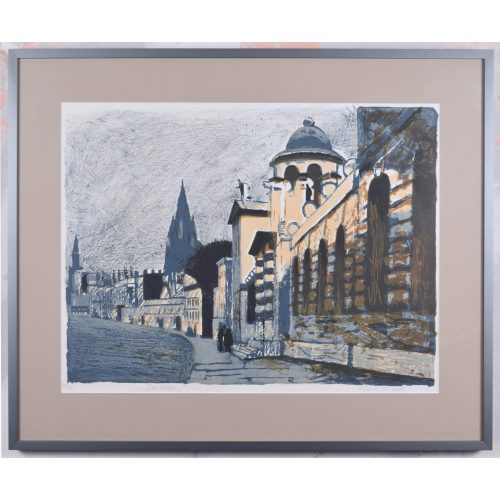
Edwin La Dell (1914-1970)
The High, Oxford
Lithograph 49 x 64 cm Signed, titled, and number 28/80 in pencil. A beautiful depiction of the golden Headington stone of Queen's College on the High Street, Oxford. The cupola above the college's entrance, and, in the background, the shadowy spire of the University Church of St Mary the Virgin, rise into the blustery sky. La Dell studied at the Sheffield School of Art, where he won a scholarship to the Royal College of Art. From 1934 to 1940 John Nash was the head of printmaking there, and taught La Dell. La Dell himself became head of lithography there in 1948, and remained in post until his death. During the war La Dell was an official war artist and a camofleur, but he is probably best known for his lithographs of Oxford and Cambridge that he published himself. His works are widely held in the public collections, including the Royal Academy and the Government Art Collection, the latter of which holds many of his views of Cambridge. Condition: very good. If you are interested, please email info@manningfineart.co.uk or call us on 07929 749056. Click here for other views of Queen's College, Oxford. -
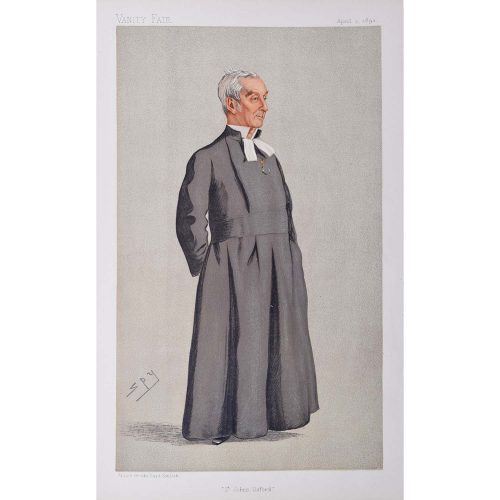
Vanity Fair Spy Magazine President of St john's College Oxford
1 April 1893 Lithograph If you are interested email info@manningfineart.co.uk or call us on 07929 749056. Condition: Good. -
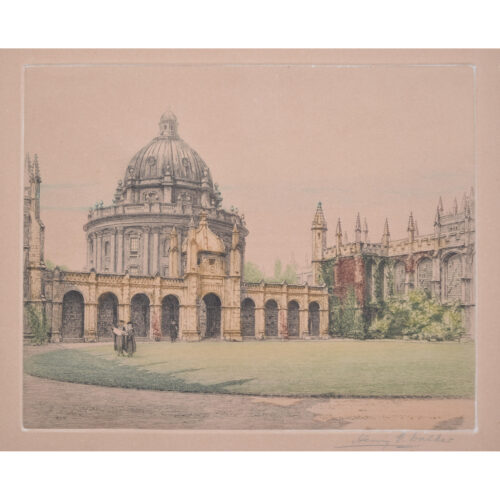
Henry George Walker (1876 - 1932)
The Radcliffe Camera from All Souls College, Oxford
Etching 20 x 25 cm Signed lower right in pencil. The artist depicts the North Quadrangle of All Souls, with the Radcliffe Camera peeking in. Two fellows contemplate a document as a third approaches. Henry Walker was born in Birmingham and specialised in architectural and landscape etchings. Condition: generally very good. If you’d like to know more, please email info@manningfineart.co.uk or call us on 07929 749056. Click here for other views of All Souls. -
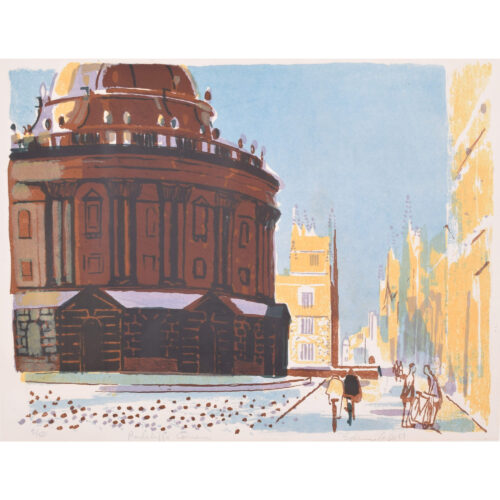
Edwin La Dell (1914-1970)
The Radcliffe Camera, Oxford
Lithograph 41 x 54 cm Numbered 2/50, titled, and signed below in pencil. Radcliffe Square in autumn shades. The Radcliffe Camera dominates the lithograph, and La Dell expertly captures the afternoon sun on the golden stone of Brasenose and the University Church. Students cycle towards the High. La Dell studied at the Sheffield School of Art, where he won a scholarship to the Royal College of Art. From 1934 to 1940 John Nash was the head of printmaking there, and taught La Dell. La Dell himself became head of lithography there in 1948, and remained in post until his death. During the war La Dell was an official war artist and a camofleur, but he is probably best known for his lithographs of Oxford and Cambridge that he published himself. His works are widely held in the public collections, including the Royal Academy and the Government Art Collection, the latter of which holds many of his views of Cambridge. Condition: generally very good. Fractional age-toning to paper; old glue marks to margin which will be under the mount when framed. If you are interested, please email info@manningfineart.co.uk or call us on 07929 749056. Click here for other general views of Oxford. -
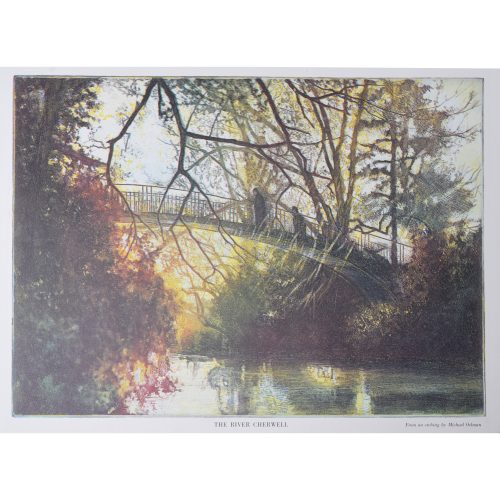
Michael Oelman (born 1941)
The River Cherwell
Lithograph 33 x 46 cm A lithograph of Oxford's wondrous River Cherwell in University Parks, from an etching by Michael Oelman. A setting sun casts its gold light over the glassy surface of the river and its surrounding trees; two figures cross the Cherwell via the famous Rainbow Bridge. The curved footbridge was built in the early 1920s by the University a project for the unemployed. Oelman's etching was reproduced as a lithograph in 1981, to be published in the "Oxford Almanack". The Oxford Almanack was an annual almanac published by the Oxford University Press for the University of Oxford from 1674 through 2019 (when printing sadly ceased due to "dwindling interest"). The almanac traditionally included engravings or lithographs of the University and information about the upcoming year. Other almanac artists have included James Basire, Michael Burghers, J. M. W. Turner, and John Piper. Michael Oelman was born in Llandudno, Wales, in 1941. He studied fine art at Reading University and then etching and lithography at the Central and Slade Schools of Art. In the 1960s he studied with S. W. Hayter in Paris, and then became a lecturer in Printmaking at Doncaster College of Art, Yorkshire. His studio is in Suffolk. Condition: very good. If you’d like to know more, please email info@manningfineart.co.uk or call us on 07929 749056. -
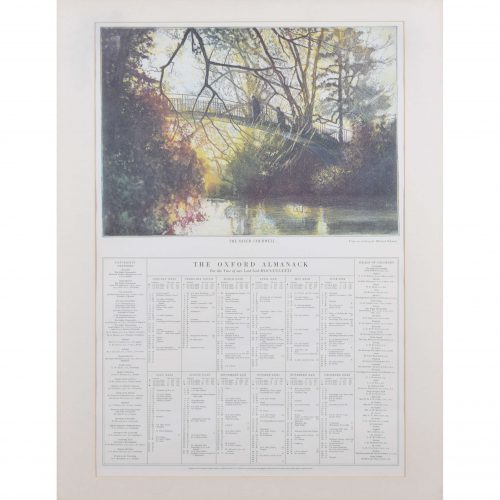
after Michael Oelman (born 1941)
The River Cherwell, The Oxford Almanac 1981
Lithograph 71 x 47 cm A lithograph featuring Oxford's wondrous River Cherwell in University Parks, after an etching by Michael Oelman. A setting sun casts its gold light over the glassy surface of the river and its surrounding trees; two figures cross the Cherwell via the famous Rainbow Bridge. The curved footbridge was built in the early 1920s by the University a project for the unemployed. Oelman's etching was reproduced as a lithograph in 1981, to be published in the "Oxford Almanack". The Oxford Almanack was an annual almanac published by the Oxford University Press for the University of Oxford from 1674 through 2019 (when printing sadly ceased due to "dwindling interest"). The almanac traditionally included engravings or lithographs of the University and information about the upcoming year. Other almanac artists have included James Basire, Michael Burghers, J. M. W. Turner, and John Piper. Michael Oelman was born in Llandudno, Wales, in 1941. He studied fine art at Reading University and then etching and lithography at the Central and Slade Schools of Art. In the 1960s he studied with S. W. Hayter in Paris, and then became a lecturer in Printmaking at Doncaster College of Art, Yorkshire. His studio is in Suffolk. Condition: very good. If you are interested, please email info@manningfineart.co.uk or call us on 07929 749056. Click here for other general views of Oxford. -
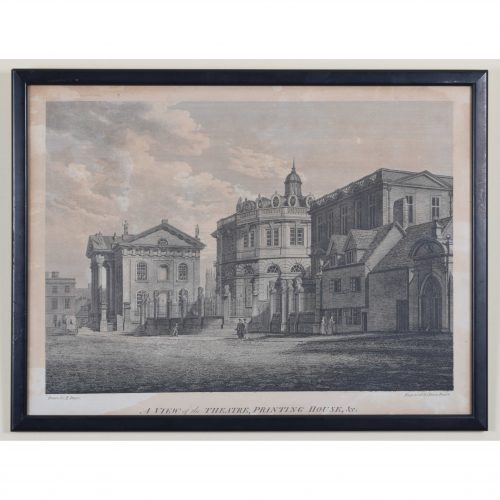
James Basire II (1769 - 1822) after Edward Dayes (1763 - 1804)
A View of the Theatre, Printing House, & c. (1800)
Engraving 36 x 49 cm A view of Broad Street, showing the Clarendon Building, Sheldonian Theatre, and what is now the Museum of the History of Science. Edward Dayes' drawing was reproduced as a lithograph in 1800, to be published in the "Oxford Almanack". The Oxford Almanack was an annual almanack published by the Oxford University Press for the University of Oxford from 1674 through 2019 (when printing sadly ceased due to "dwindling interest"). The almanack traditionally included engravings or lithographs of the University and information about the upcoming year. Other almanack artists have included Michael Burghers, J. M. W. Turner, and John Piper. Basire and Dayes collaborated on several views of Oxford during the courses of their careers. Edward Dayes was a British painter and engraver. He exhibited topographical views at the Royal Academy from 1786 until his death, and is the author of an ''Excursion through Derbyshire and Yorkshire,'' ''Essays on Painting; Instructions for Drawing and Colouring Landscapes'', and ''Professional Sketches of Modem Artists''. James Basire II was a British engraver, son of James Basire I, also a celebrated engraver. In 1802 he became Engraver to the Society of Antiquaries. Condition: some browning, as visible in photograph. If you’d like to know more, please email info@manningfineart.co.uk or call us on 07929 749056. -
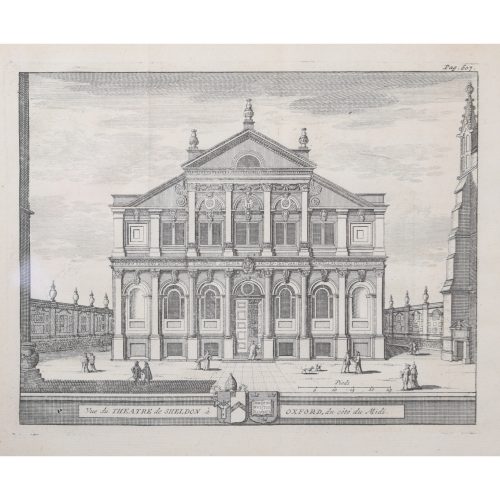
Pieter van der Aa (1659-1733), after David Loggan (1634–1692)
The Sheldonian Theatre, University of Oxford (1727)
Engraving 12 x 16 cm An eighteenth-century view of Oxford's marvellous Sheldonian Theatre, engraved by Pieter van der Aa after David Loggan, the noted engraver, draughtsman, and painter. Christopher Wren designed the building and it was constructed between 1664 and 1669; it takes its name from Gilbert Sheldon, chancellor of the University at the time and the Theatre's main financial backer. Pieter van der Aa of Leiden was a Dutch publisher best known for preparing maps and atlases, though he also printed editions of foreign bestsellers and illustrated volumes. He is noted for the many engravings he produced after David Loggan's series of Oxford and Cambridge colleges and costumes. In 1727 Van Der Aa illustrated "Les Delices de la Grande Bretagne & de L'Irelande" by James Beeverell, the book in which this engraving appears. Condition: a good impression. If you’d like to know more, please email info@manningfineart.co.uk or call us on 07929 749056. -
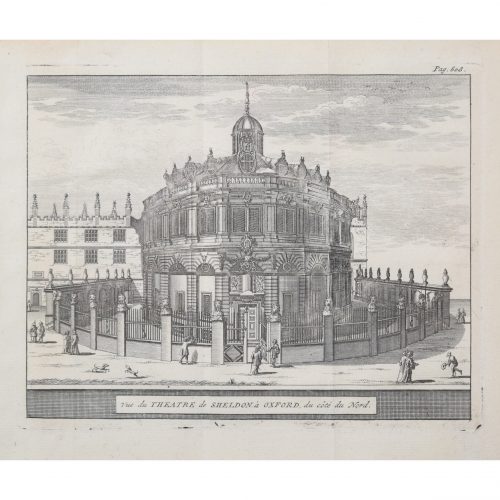
Pieter van der Aa (1659-1733), after David Loggan (1634–1692)
The Sheldonian Theatre, University of Oxford (1727)
Engraving 12 x 16 cm An eighteenth-century view of Oxford's marvellous Sheldonian Theatre, engraved by Pieter van der Aa after David Loggan, the noted engraver, draughtsman, and painter. Christopher Wren designed the building and it was constructed between 1664 and 1669; it takes its name from Gilbert Sheldon, chancellor of the University at the time and the Theatre's main financial backer. Pieter van der Aa of Leiden was a Dutch publisher best known for preparing maps and atlases, though he also printed editions of foreign bestsellers and illustrated volumes. He is noted for the many engravings he produced after David Loggan's series of Oxford and Cambridge colleges and costumes. In 1727 Van Der Aa illustrated "Les Delices de la Grande Bretagne & de L'Irelande" by James Beeverell, the book in which this engraving appears. Condition: a good impression. If you’d like to know more, please email info@manningfineart.co.uk or call us on 07929 749056. -
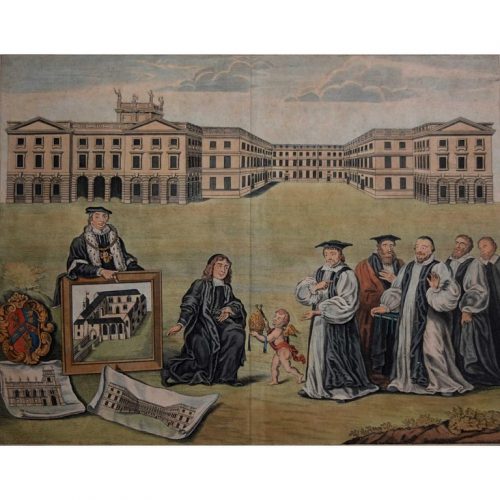
Engraving of architect showing plans of Trinity College Oxford and its chapel, behind larger elevation of Garden (early 18th Century)
Hand coloured engraving, anoymous 36.5 x 47.5 cm Rare - we have been unable to identify another copy of this print. The architect pictured has been suggested to be Henry Aldrich who designed the chapel at Trinity College, hence seen here with the plans thereof. The figures stand before the buildings of the Garden Quadrangle, built by Christopher Wren. Aldrich was Canon and Dean of Christ Church, Oxford. As well as a polymath and composer, he was a prolific architect working in the Palladian style, writing 'Elemena Architectuae Civilis' (1789) and designing Peckwater Quadrangle at Christ Church (1707-14). Condition:Generally good with some spotting and slight overall toning. Trimmed to just within platemark at top and bottom. If you are interested email info@manningfineart.co.uk or call us on 07929 749056. -
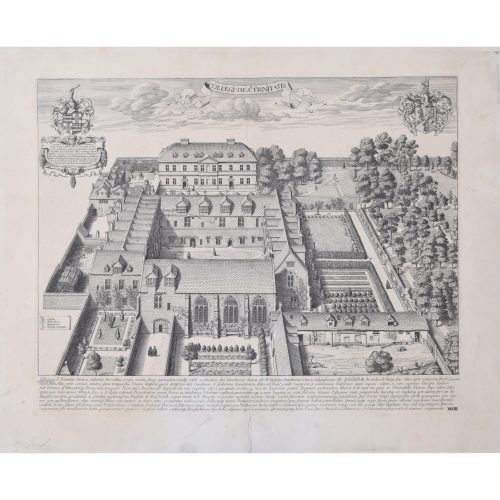
David Loggan (1634 - 1692)
Trinity College, Oxford (1705)
Engraving 32 x 41 cm Loggan's view of Trinity from the second edition of the 'Oxonia Illustrata'. Loggan was born to English and Scottish parents, and was baptised in Danzig in 1634. After studying engraving in Danzig with Willem Hondius (1598-1652 or 1658), he moved to London in the late 1650s, going on to produce the engraved title-page for the folio 1662 Book of Common Prayer. He married in 1663 and moved to Nuffield in Oxfordshire in 1665. Loggan was appointed Public Sculptor to the nearby University of Oxford in the late 1660s, having been commissioned to produce bird’s-eye views of all the Oxford colleges. He lived in Holywell Street as he did this. The 'Oxonia Illustrata' was published in 1675, with the help of Robert White (1645 - 1704). Following its completion, Loggan began work on his equivalent work for Cambridge; the 'Cantabrigia Illustrata' was finally published in 1690, when he was made engraver to Cambridge University. The 'Oxonia Illustrata' also includes an engraving of Winchester College (Winchester and New College share William of Wykeham as their founder) whilst the 'Cantabrigia Illustrata' includes one of Eton College (which shares its founder, Henry VIII, with King’s College). Bird’s-eye views from this era required a particular talent as an architectural perspectivist; it was not until 1783 that it became possible for artists to ascend via hot air balloons and view the scenes they were depicting from above. Loggan thus had to rely on his imagination in conceiving the views. Loggan’s views constitute the first accurate depictions of the two Universities, in many ways unchanged today. Whilst the Oxford engravings were produced in reasonable numbers and ran to a second edition by Henry Overton (on thicker paper and with a plate number in Roman numerals in the bottom right-hand corner), those of Cambridge were printed in much smaller numbers. The Dutchman Pieter van der Aa published some miniature versions of the engravings for James Beverell’s guidebook to the UK, 'Les Delices de la Grande Bretagne' (circa 1708). The contemporary artist Andrew Ingamells has produced a highly-acclaimed series of etchings which bring Loggan’s original vision up to date. Condition: generally very good; second edition. If you’d like to know more, please email info@manningfineart.co.uk or call us on 07929 749056. -
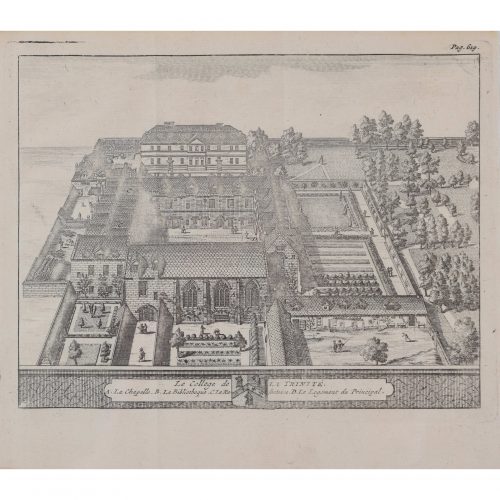
Pieter van der Aa (1659-1733), after David Loggan (1634–1692)
Trinity College, Oxford (1727)
Engraving 12 x 16 cm An eighteenth-century view of Trinity College, engraved by Pieter van der Aa after David Loggan, the noted engraver, draughtsman, and painter who specialised in engravings of Oxford and Cambridge. Pieter van der Aa of Leiden was a Dutch publisher best known for preparing maps and atlases, though he also printed editions of foreign bestsellers and illustrated volumes. He is noted for the many engravings he produced after David Loggan's series of Oxford and Cambridge colleges and costumes. In 1727 Van Der Aa illustrated "Les Delices de la Grande Bretagne & de L'Irelande" by James Beeverell, the book in which this engraving appears. Condition: a good impression. If you’d like to know more, please email info@manningfineart.co.uk or call us on 07929 749056. -
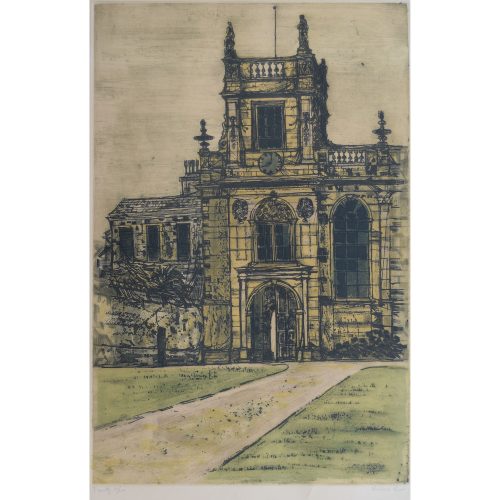
Richard Beer (1928 - 2017)
Trinity College, Oxford (1964 / 65)
Etching and aquatint 42.5 x 58 cm Numbered 27 / 100. Published by Editions Alecto. A copy of this print, owned by the Government Art Collection, is currently in the British Embassy in Saudi Arabia. Richard Beer was a painter and printmaker who focused on architecture and landscapes. He studied at the Slade School of Art from 1945 to 1950 and then studied at the École des Beaux Arts in Paris on a French Government Scholarship. He then worked and studied at Atelier 17, an art school and studio run by the artist Stanley William Hayter (arguably one of the most significant printmakers of the 20th century). The atelier was highly influential in the study and promotion of 20th-century printmaking, and it was here that Beer developed his etching skills. Beer then went on to work for the Royal Ballet choreographer John Cranko, designing the sets and costumes for "The Lady and the Fool" at the Royal Opera House in Covent Garden. He also produced several book illustrations and book jacket designs. Beer taught printmaking at the Chelsea School of Art for 40 years and was also a founding member of the Printmakers' Council. He travelled widely through Italy, France, Spain, and Morocco, sketching prolifically and painting rural and architectural landscapes. Beer would then make etchings and paintings in his Primrose Hill studio, inspired by the landscapes he had sketched and seen while travelling. Probably his greatest work was a collaboration with John Betjeman to produce a portfolio of prints of ten Wren Churches in the City of London for Editions Alecto, copies of which are in The Government Art Collection. That collection contains a total of 54 prints by Beer, and the Tate Gallery’s collection holds another seven. His series of Oxford architectural engravings was also produced for Editions Alecto, as was a series of predominantly architectural views in Southern Europe. If you are interested, please email info@manningfineart.co.uk or call us on 07929 749056. Click here for other views of Trinity College, Oxford. -
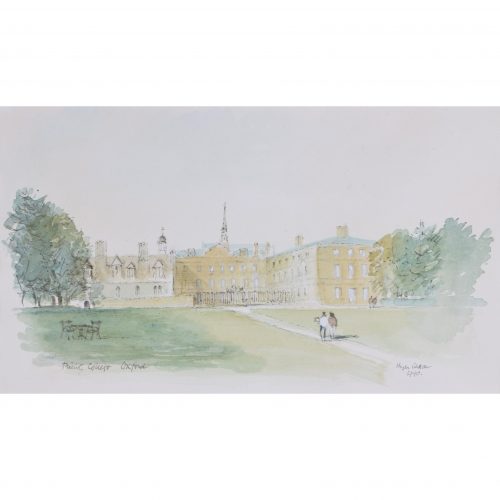
Hugh Casson (1910 - 1999)
Trinity College, Oxford (1990)
Watercolour 20 x 33 cm (38 x 50 cm framed) Casson's marvellous watercolour of Trinity and its perfectly manicured lawns, adorned with strolling undergraduates. Sir Hugh Casson was educated at Eastbourne College; St John’s College, Cambridge; and the Bartlett School of Architecture. Trained in the 1930s in the early modernist style, he taught at the Cambridge School of Architecture. After employment as a camoufleur during World War 2 by the Air Ministry, in 1948 he was appointed as director of architecture for the Festival of Britain. A close friend of the Royal Family, he undertook designs for the 1953 coronation, designed the interior of the Royal Yacht Britannia (“The overall idea was to give the impression of a country house at sea”), and taught the young Charles III to paint in watercolours. Amongst his architectural achievements are the Elephant House at London Zoo, the 1978 redevelopment of Bristol Docks, the Raised Staff Building for The University of Cambridge, and a building for the Royal College of Art. He published a number of illustrated books, of which Casson’s Oxford and Casson’s Cambridge are probably the best known. A limited edition series of prints was produced from the paintings. Condition: excellent. If you’d like to know more, please email info@manningfineart.co.uk or call us on 07929 749056. Click here for other views of Trinity College, Oxford. -
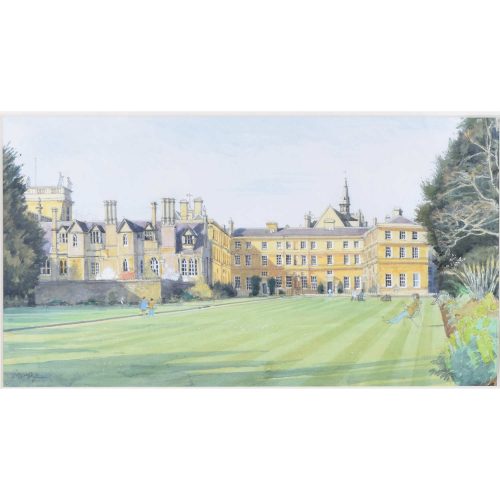
John Doyle (born 1928)
Trinity College, Oxford
Watercolour 24 x 46 cm Signed lower left. Doyle's striking portrayal of Trinity's architecture, complete with undergraduates variously strolling, sitting, and reading in the foreground. Afternoon sun slants over the immaculately mown lawns. John Doyle was born in London and works in watercolours, pastels, and oils. He studied at the Maidstone School of Art in his 30s, later showing at the Royal Academy Summer Exhibition. Much of his work focuses on landscape and architecture; he has produced a series of views of Oxford and its colleges. Condition: excellent. If you’d like to know more, please email info@manningfineart.co.uk or call us on 07929 749056. Click here for more views of Trinity College, Oxford.

